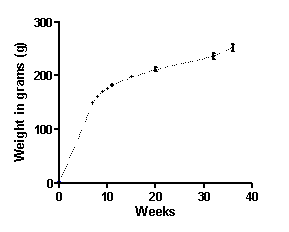| pA2 online © Copyright 2004 The British Pharmacological Society |
026P
University of Buckingham 3th Focused Meeting April 2004 |
|
The relationship
betweeen starting body weight and weight gain in female hooded-lister
rats
|
|
Weight gain leading to obesity is a frequently occurring problem with drug therapy for psychiatric disorders, which can lead to increased morbidity and reduced compliance (Allison et al., 1999). Increasingly, rodent models are used to assess the impact of drugs on body weight gain. During the course of such studies in our laboratory we have observed that control levels of weight gain may depend on the starting weight of the animals (Fell et al., 2004, in press). The aim of the present study was to investigate the relationship between weight gain and starting body weight in female rats.
Subjects were 35 female hooded-Lister rats group housed under standard laboratory conditions with free access to food and water. Animals were allocated to one of four groups (A to D) according to starting body weight and received distilled water (i.p) once per day for 21 days. Body weight, food and water intakes were measured daily. On day 21 animals were sacrificed and intra-abdominal fat measured. Statistical comparisons were made using 2 way and 1 way ANOVA with post hoc Dunnett's t-test. Data are expressed as mean ± SEM (n=5/6 per group and per cage). A further 12 rats were not sacrificed at this time and were weighed until aged 38 weeks.
Some significant differences in percentage body weight gain were observed during weeks 2 and 3 but not week 1 (see table 1), with weight gain being most marked in the smaller rats. No significant differences in food and water intake or intra-abdominal fat deposition were observed between any of the groups. Figure 1 shows that body weight increased most rapidly until animals reached 200g.
Fig 1. Growth curve of female hooded-Lister rats (n=12)

Table 1. Effect of initial starting body weight on percentage weight gain over a three week period
| Group (n) |
Initial
body weight (g)
|
Percentage
weight gain (%)
|
||
|
Week
1
|
Week
2
|
Week
3
|
||
| A (6) |
188±4.0
|
3.7±0.8
|
7.8±0.8*
|
12.3±1.2*
|
| B
(6) |
197±5.1
|
3.3±0.8
|
6.4±0.9
|
8.5±1.2
|
| C (6) |
211±4.0
|
2.2±0.5
|
3.8±1.1
|
3.6±1.4
|
| D (5) |
237±7.5
|
1.4±1.2
|
4.4±1.3
|
3.8±1.4
|
The data presented here confirm the hypothesis that the body weight gain of female rats is strongly influenced by starting body weight. These findings have significant relevance for future drug induced weight gain studies using female rats.
Allison D.B et
al (1999). Am J Psychiatry.156, 1686-96.
Fell M.J et al, (2004) J.Psychopharm 18 (2):
in press.